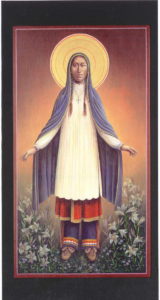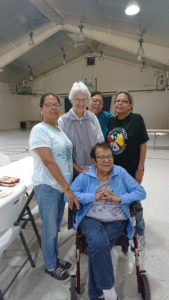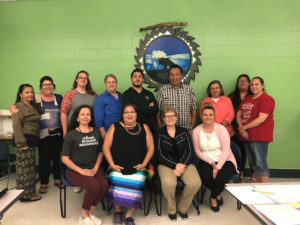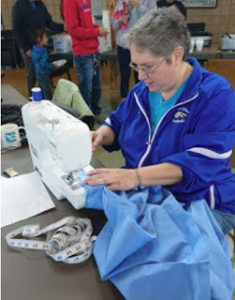The Kateri Initiative renews Salvatorian presence among First Nations people

When Sisters Irene DeMarrias, Rita Faust and Mildred Lotzer left Sisseton, South Dakota in the mid-1990s, our religious community thought our time was up in this small, rural community. For more than 70 years, Salvatorian Sisters had ministered on the Lake Traverse Reservation of the Sisseton-Wahpeton Oyate in schools, hospitals, nursing homes and parishes. Sisters of the Divine Savior didn’t return to Sisseton for almost 20 years, but the rural community and its people were never far from our hearts. In 2014, after four years of discernment, our community approved a new initiative that renewed our Salvatorian presence on the Lake Traverse Reservation. The Kateri Initiative, started by Sister Patrice Colletti, is an emerging pastoral ministry in Sisseton. Its name honors St. Kateri Tekakwitha, patron of the Indigenous peoples of the North American continent.

Following approval of the Initiative, Sisters Patrice Colletti and Janice Hartman moved to Sisseton. Sr. Janice served as a certified nursing assistant (CNA) at Tekakwitha Living Center, and Sr. Patrice as a secondary-level special education teacher and program developer at Tiospa Zina Tribal School. They also volunteered at St. Kateri Parish, where Sr. Patrice lectors and serves on a parish committee dedicated to translating hymns into the Dakota language. “When finished,” says Sr. Patrice, “the song book will be widely used by various Christian groups, not just Catholic.”
As if she weren’t busy enough, Sr. Patrice also helped launch the Adult Services Task Force, which continues today. She describes it as a “cross-organizational, cross-boundaries, cross-agency group working together to improve the quality of life of adults (18+) with disabilities.” So far, the task force has helped to secure handicap-accessible county-wide bus transportation, disability accessibility at the tribe’s homeless shelter, and secured a three-year grant to implement vocational rehabilitation services for tribal members.

After Sr. Janice returned to Milwaukee, Sister Rita Vogelsang joined Sr. Patrice in Sisseton in 2016. Calling on her experience from years serving in Birmingham, Ala., Sr. Rita unpacked her ministerial gifts to respond to needs in Sisseton. She provided pastoral care to elders at Tekakwitha Living Center; engaged with local women in meaningful bible studies; helped orient new members of St. Kateri Parish, where she also served as a Eucharistic minister; and helped ecumenical pastors establish a food pantry to serve the town. Sr. Rita departed Sisseton after three years to serve at the Arizona-Mexico border with Sister Darlene Pienschke in 2019.
In 2020, Sr. Patrice is the only Salvatorian Sister serving in Sisseton. She fills her day teaching elementary students at Tiospa Zina Tribal School, and continues building connections with tribal and non-tribal communities. Before the pandemic, she took part in wacipis (pow-wows), and attended special events ranging from Christmas pageants to car shows to fire department chicken dinners. Since COVID-19 struck, she has worked as an essential staff member along with her teacher colleagues.

“All of us are again ‘new’ teachers because we’re trying to do something never before attempted,” says Sr. Patrice. “We have no models and there’s very little research. Teaching online, along with teaching in school — with masks, face shields and gloves — is quite a challenge. It’s extremely stressful for teachers, especially as COVID infections continue to grow by two-digit numbers, and treasured elders and parents die.”

The Kateri Initiative is building a bridge between Salvatorian Sisters and people in and around Sisseton. Sisters Patrice, Janice and Rita have renewed the legacy of Sisters Irene, Rita Faust and Mildred, who once served the community so well. In fact, Sister Rita Faust says she’d go back to Sisseton if she were physically able to do so. And what about Sisters Irene and Mildred if they were alive today? Sister Patrice ventures a guess saying, “They would be delighted and, I think proud, especially that the Kateri Initiative is helping SDS improve our own ability to embrace cultural diversity and respect the history and vibrant cultures of this continent’s native peoples.”
Our 125 Year Celebration
As we look back on our 125th anniversary of coming to the USA, we invite you to reminisce with us. We've launched all 5 time lines with historical milestones and stories that bring to life the experiences of our sisters who came before us.
Era 1: 1895-1920
Responding to Immigrant Needs
The missionary response of hearty immigrant women religious characterizes the first 25 years of Salvatorian Sisters’ presence in the United States ...
Era 2: 1920-1950
Expanding in an “American” Church
By 1920, life for a Salvatorian Sister in the USA was radically different than it had been 25 years earlier. World War I ....
Era 3: 1950-1970
Embracing Renewal
Bob Dylan’s 1964 classic, The Times They Are A Changing, captures the high energy of this era. Change was afoot both outside and inside the Salvatorian convent walls...
Era 4: 1970-2000
Building Collaboration
Events of the mid-1960s renewed the collaborative energy that had always characterized Salvatorian life. Cloistered living ...
Era 5: 2000-2020
Searching for New Footing in a Changing World
When the new millennium arrived on January 1, 2000, Salvatorian Sisters were already five years into our second century on USA soil. Our ...
